Whitley P4942 at Appleton le Street, Malton.
On the night of 23rd / 24th September 1940 crews of 77 Squadron were tasked with flying operational flights to bomb Berlin, the raid consisted of 129 aircraft and between them they bombed seven railyards, six electric power stations, three gas works and two factories employed in making aircraft parts. In a three hour period 112 aircraft dropped bombs from between 4,500 and 16,000 feet, but searchlights and ground mist made identifying the targets hard. This specific aircraft took off from Linton on Ouse at 20.16hrs and bombed from between 9,000 and 6,000 feet in a glide across the city. On their return to Yorkshire in the early hours of the 24th this aircraft ran low on fuel and before their base of Linton on Ouse could be reached. The aircraft ran out of fuel in the Malton area and with height being lost the pilot made a good wheels-up forced landing near Appleton le Street without injury to the crew. The Squadron ORB gives the time as being 05.55hrs though an earlier time of 04.00hrs has also been located; the ORB is probably correct. The aircraft had flown very low over the village and it's pilot was able to pull the nose of the aircraft up in order to
avoid hitting the church tower, it was then belly landed in a field behind the church and came to rest virtually intact. The photograph of the aircraft shown below shows the propellers in an unbent states, this usually means the engines were not turning when the aircraft touched down, and in this case backs up the story of it being totally out of fuel. A retired Army officer; surname of "Knobbs", took the crew to his house in Amotherby where he gave them breakfast before the RAF authorities arrived to collect them and return them to Linton on Ouse.
Appleton resident (now late) Mr Ray Magson recalled the events to me in the mid-2000's. He recalled an RAF maintainance unit had spent some time at the crash site taking the aircraft to pieces and removing it all by road. They lived in tents at the site during this period which was probably common practice. During this time here they were often visited by local children, some of whom (including Ray) collected scraps of the aircraft. The main bulk of the aircraft was taken away on large trailers and rebuilt. Mr Magson gave me the fragments of the aircraft he had collected. I thank him for recounting his memories to me, he sadly died a few months after I spoke to him.
Pilot - F/O Antony Charles Letteblere Akroyd-Stuart RAF (72476). He later served as "A C L A Stuart".
Second Pilot - P/O Douglas Robert Bagnall RAF (43021).
Observer? - Sgt Lord (Possibly Sgt Derek Rowland Lord RAFVR (1169117)).
Wireless Operator / Air Gunner - Sgt Albert Edward Hammond RAF (535641).
Air Gunner - Sgt Middleton. (Probably Sgt James William Middleton RAF (937840)).
The photograph above shows Whitley P4962 in the field near Appleton le Street.
The same field in 2009 and probably the crash site, though perhaps I am slightly too high up the field.
This group photograph of 77 Squadron aircrew shows at least two of those named above. Douglas Robert Bagnall is shown on the bottom row, third from left. Antony
Akroyd-Stuart is probably the pilot shown on the front row, far right.
Douglas Robert Bagnall was known by his second name, he was granted a short service commission in the RAF as Acting P/O on probation on 23rd March 1940. On the
night of 23rd / 24th November 1940 he was the captain of Whitley T4160 tasked along with five other 77 Squadron aircraft and four 102 Squadron aircraft with bombing
the Royal Arsenal, Turin. Having flown a staging flight to re-fuel at Horsham St.Faith in Norfolk they set out on the long flight to Italy. The raid does not appear
to have been a success with his aircraft and others not landing safely when they returned. He later recorded his memories of this flight and believed that incorrectly
forecast weather and specifically wind resulted in them probably drifting off course, they spent a long time trying to identify a target eventually dropping their
bombs on fires from previously dropped bombs possibly in Genoa. They made a rough calculation of where they might be and plotted a course back to England. On the
return leg and while flying over The Alps the aircraft developed a problem with the airscrew pitch control on one engine, this sped the engine up and would have used
more fuel so they slowed the aircraft down to try to save fuel. This problem combined with the distance to Italy and spending time searching for a target resulted
in them being low on fuel as they crossed France. Still not sure of their exact position and with fuel running low after crossing what they thought was the French
coast they transmitted signals to state they were probably gong to ditch. The aircraft eventually ran out of fuel and on spotting two boats below P/O Bagnall ditched
near them having first instructed his crew to the back of the aircraft to then launch the dinghy when the aircraft came to a stop. The ditching was successful but
when P/O Bagnall climbed out of the cockpit and along the top of the aircraft down to the where he expected the crew to have launched and be climbing into the dinghy
there was no dinghy. As the Whitley was sinking fast the crew left the aircraft and went into the water and this was the last Bagnall saw of the rest of his crew. He
attracted the attention of the boats by torch and was he eventually dragged on board by their crew. Although the two boats spent some time searching for his crew no
trace was ever found of them and they are all commemorated on the Runnymede Memorial. It later transpired the aircraft ditched only a few miles off the English coast,
believed to have been in the Straits of Dover.
P/O Bagnall returned to operational flying and flew his next as captain on 7th December 1940. He was awarded the DFC for service with 77 Squadron, Gazetted on 6th
June 1941. He was graded as P/O on probation on 13th July 1940 and promoted to F/O (War subs) on 13th July 1941 and F/Lt (war subs) on 13th July 1942. After finishing
a Tour with 77 Squadron he later (probably) served in Transport Command and served in North Africa. He survived a forced landing in the Atlas Mountains area and the
aircraft was later flown out after a strip was created to allow a take off run. He survived a fourth serious accident but the details surrounding it are not known,
believed to have been while flying a large aircraft and while landing it crashed with the possibly deaths of a number of the crew. Little is yet known about this
incident. He was transferred to the RAFO and called up for service on 11th September 1943 but relinquished his commission on appointment to the RNZAF on 1st January
1944 while in the rank of F/Lt. He survived two other accidents before leaving the RNZAF just before the Korean War. He was born in Palmerston North, New Zealand in
October 1910 and died in Auckland in October 1996. I thank his son for contacting me in September 2014.
Antony Charles Letteblere Akroyd-Stuart (or incorrectly spelt "ACkroyd-Stuart" in many places) was probably born in Halifax, Yorkshire but it is possible that his
family moved to Australia when he was young. He was granted a commission in the General Duties Branch of the RAFVR on 13th September 1938 as P/O but transferred to the
RAF on 7th October 1939 though his seniority of P/O was then back dated to 7th July 1939. He was promoted to F/O on 7th April 1940 with seniority back dated to 7th
January 1940 and rose to F/Lt exactly a year later with the same back dated seniority. He was promoted to S/Ldr (temp) on 1st March 1942 and later confirmed in the
S/Ldr rank. Following the incident at Appleton le Street little more is known about him other than he is listed elsewhere on the internet as commanding 34 EFTS on
14th August 1941, and on this date the Duke of Kent inspected the Medicine Hat base in Canada. Although under research I suspect he completed a Tour with 77 Squadron
and took a posting in Canada. Having spent time instructing it then appears likely that he volunteered for further service in the UK following this period in Canada
and returned to the UK and begun a second Tour after transferring back to the RAFVR. He then served with 76 Squadron but was sadly killed on 31st August 1943 when
Halifax DK207 (carrying nose art of "Saint the Second") was shot down by a night fighter and crashed in Holland. Five of the crew including him were killed and two
others were made PoW. S/Ldr Akroyd-Stuart was twenty six years old.
The Akroyd-Stuart Prize given by the Royal Aeronautical Society is likely to have been created in memory of the pilot's Uncle who invented the "Hornsby-Akroyd
Patent Oil Engine", this was an engine which worked similar to that of the diesel engine and there were patent issues between the two companies involved. Although
Diesel is credited and thus the famous name it was probably Akroyd-Stuart who invented the type of engine. It was the pilot's father along with this brother, who,
on moving to Australia set up the Sanders & Stuart company.
Sgt Albert Hammond was involved in a number of incidents. He survived the crash of Whitley T4138 on the North Yorkshire Moors on 15th December 1940 and after converting to Halifaxes and transferring to 35 Squadron he survived Halifax L9498 crashing at Linton on Ouse in June 1941. F/Sgt Albert Hammond was killed on 9th July 1941 when Halifax L9521 was shot down over The Netherlands, the aircraft sadly crashed onto a house killing three crew and four people in the house. He is buried at Uden War Cemetery, Noord-Brabant, Netherlands.
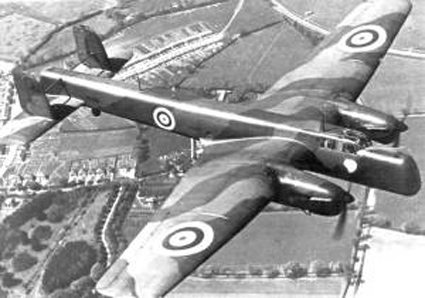
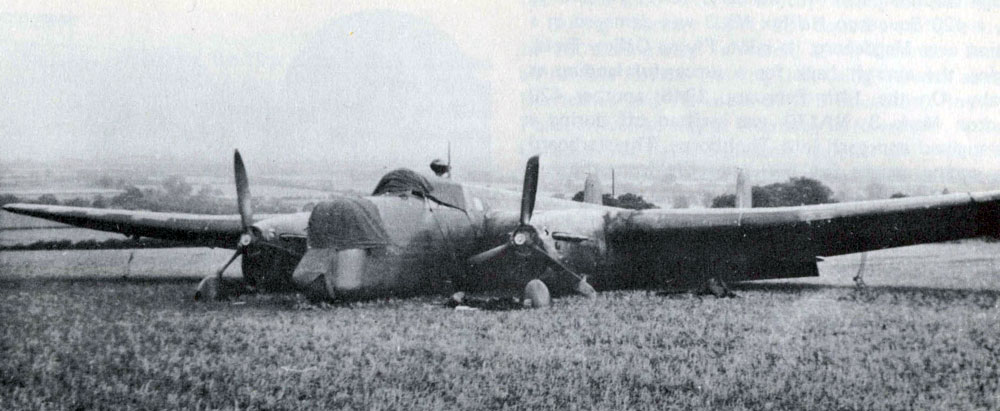
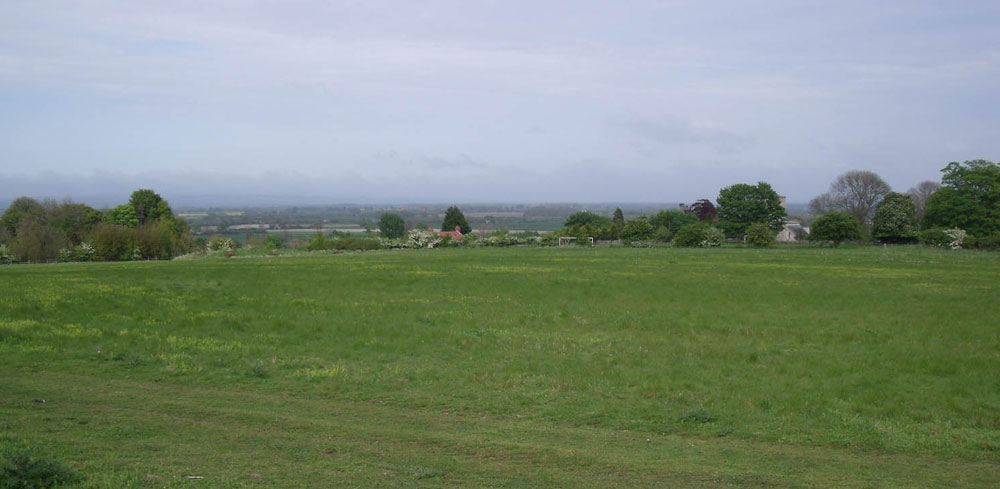

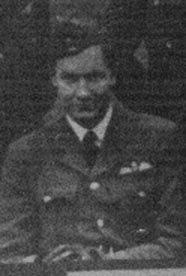

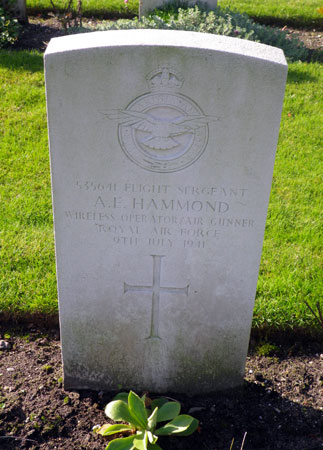
Sgt James Middleton was awarded the DFM for service with 77 Squadron on 18th July 1941 and was also Mentioned in Despatches on 1st January 1942. He was probably
instructing at the time of the Thousand Bomber raids and flew the Cologne one on 31st May 1942 and Essen one 2nd June 1942 with 22 OTU. By the middle of 1942 he was
flying with 115 Squadron, on the night of 27th / 28th August 1942 he was flying in Wellington BJ710 on Ops to Kassel when the aircraft was shot down over Germany.
He was the only survivor and he saw out the end of the War as a PoW.
Sgt Lord's full identity is not yet known. He may have been Derek Rowland Lord RAFVR (1169117) who is known to have served with 102 Squadron in mid-1941 but may
have been with 77 Squadron. He was later killed flying Defiant L6981 on 13th August 1942 in a crash near Hutton Cranswick.
Whitley P4942 was built to contract 75147/38 by Armstrong Whitworth Ltd at Baginton, it was awaiting collection on 5th April 1940 and was delivered to 77 Squadron
at Kinloss later in the month. On 4th May 1940 it moved with the unit to Driffield and having survived the bombing of Driffield it moved to Linton on Ouse with 77
Squadron on 28th August 1940. Following the incident at Appleton le Street on 24th September 1940 Cat.R/FB damage was recorded and it was removed from the site by
road. It was repaired in works and on completion of repair and after a short period of MU storage it was taken on charge by 10 OTU at Abingdon. On 1st October 1941
it undershot on landing at Abingdon and the undercarriage collapsed. After assessment it was deemed beyond repair and struck off charge.